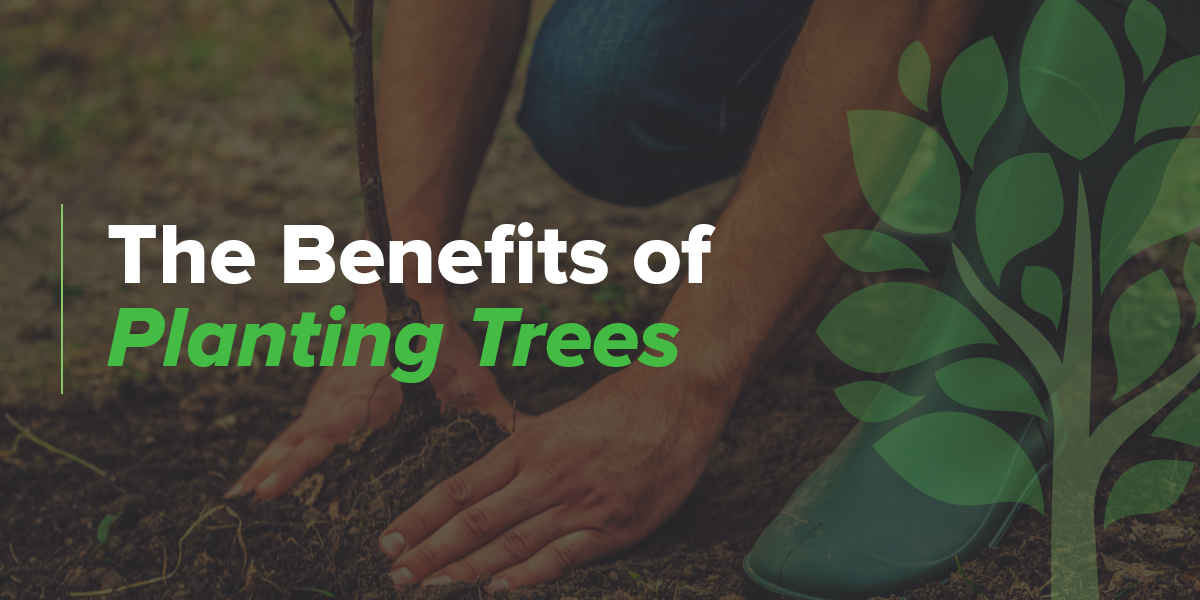Trees are the oldest living things on earth. They are not only planted to adorn our landscapes and to provide shades. Planting trees is also an easy and sustainable way of positively affecting the environment. The importance of planting trees cannot be over-emphasised. They help to cleanse the air, filter our water, and provide a home to over eighty percent of the world’s terrestrial creatures. They are also vital ingredients in twenty-five percent of all drugs.
There are several advantages of planting trees, including the following:
1. Economic Benefits
Some of the benefits of planting trees are economical, and they could be direct or indirect. Trees and forests provide jobs to over one billion people around the world. They also provide raw materials used in construction and making paper among a million other products.
2. Increase in Home Value

Having a well-landscaped piece of property with healthy trees could also help to increase the value of the property. This increase in the aesthetic value of the property leads to an increase in its overall valuation. Trees can also be used to complement the architectural design of the property. The growth in the monetary value could be as much as twenty percent.
3. Natural Air Conditioning
Planting trees in the right places could also bring about some great benefits, such as reduced air-conditioning costs. When trees are well placed, they could provide a natural cooling effect in the summer. They could also provide warmth in the winter, mainly if they are deciduous trees.

Naturally, trees also help with energy conservation. The process of evapotranspiration (a combination of evaporation and transpiration) helps the air to be cooler and moister. Also, trees help to create cooler temperatures because of their low albedo. Albedo is the solar energy that is not absorbed into a surface but reflects off it back to space. Where the albedo is high, it results in high temperature and vice versa.
Furthermore, trees help to reduce the amount of Freon that is emitted into the environment. This would, in turn, reduce the damage done to the ozone layer by this odourless and dangerous chemical.
For Garden Design Essex – Call us 01245 901537
Environmentalists and architects have developed a solution to protecting the environment from harmful emissions while helping people save money on air conditioning bills. The simple solution is to try out green roofs (basically trees on roofs).
4. Erosion Control
Wind and rain are the two main agents of erosion that cause damage to the soil. Because rain falls from great heights, the momentum, and the force with which they hit the earth can damage the soil. However, when the land is dry, the wind can cause severe damage to the soil. Trees help to weaken the force of these two agents, thereby controlling soil erosion. Furthermore, their roots help to hold the soil together to reduce the damage winds could cause.
Trees also help the soil to retain moisture by lowering the soil temperature through the organic remains produced.
5. Air Purification
The quality of the air we breathe in has depreciated over the years. The atmosphere is saturated with dangerous greenhouse gases which are not beneficial to the environment. The Intergovernmental Panel on Climate Change (IPCC) has said that carbon dioxide (CO2) makes up a majority of the greenhouse gases.
The advantages of tree planting to absorb these harmful gases is a brilliant idea. Trees naturally soak up carbon dioxide, thus reducing its concentration in the atmosphere. The average tree can absorb up to a few hundred pounds of carbon dioxide. The absorbed gas is later used to create sugar, which helps to provide energy and release oxygen, which we breathe. Naturally, this results in healthier and cleaner air in the atmosphere.
6. Health Benefits
Trees provide several health benefits, such as being used to make medicine. More than twenty species of trees found in the UK contain medicinal properties. For example, the oil from birch bark contains antiseptic properties.
Trees also help to protect against heat-stroke, disease, and depression. Also, they promote cleaner air and better sleep for people. It has also been suggested that trees help to reduce air pollution and the risk of respiratory diseases like asthma.
7. Habitat For Wildlife
This is one of the most apparent advantages of tree plantation. Different reptiles, birds, and insects use trees as sources of their food, shelter, and homes. For example, an apple tree produces close to twenty bushels of fruit annually, which can feed many animals. It only occupies a small land surface, but its benefits to the environment are numerous. Examples of trees that animals often make their homes in include sycamore and oak trees.
Planting many trees in an area help to increase the biodiversity of said area. Depending on what kind of trees are planted, their leaves, fruits, and flowers may provide some benefits to wildlife. Also, the organic remains of these trees enrich the soil, making it more fertile for more trees to grow. They also provide more places for wildlife to find security, safety, and food.
8. Conservation And Filtration Of Water
This is one of the most significant advantages of planting trees. As a result of the shade they provide, trees ensure the slow evaporation of water. Water from storms is usually filled with nitrogen and phosphorus pollutants. However, trees help to break the rainfall and channel the water into the ground instead, thus preventing the ocean from becoming polluted.
Researchers have proven that trees can be used to filter water. They created a water filter with a tree branch that contained many xylem tissues. The tissues trapped most of the harmful E.coli bacteria present in some unclean water. Afterwards, the water was clear and uncontaminated.
9. Flood Control
Storms have become quite severe and frequent all over the world. Many states and cities have tried to use vegetation as a means of controlling the damage caused by storms. Research has suggested that the planting of trees around a river may reduce the height of flooding by as much as twenty percent.
Natural flood management is the use of trees, wood, and hedgerows to reduce the risk of flood. There are many ways that trees could be used to control or prevent flooding. It could be by the direct interception of rainfall. It could also be because planting trees around a river ensure that the trees make use of the water. Therefore, this would result in a reduction of the water level in that area. Finally, it could also be because trees act as a drag on flood water, reducing the amount of how much is released.
10. Social Benefits
The social benefits of tree plantation are numerous. Trees have a calming effect on humans and help create a serene and tranquil environment. They have been proven to help alleviate stress, fatigue and boost one’s general health, and learning capacity. Simply put, trees help make life easier.

Also, trees are planted as living memorials or to mark important events because of their long lifespan. A bond may be formed between humans and trees, and this is evident when people protest against the felling of a tree. Trees give us a link between generations, our past, present and future.
11. Source Of Renewable Energy
One of the biggest problems in the world is fossil fuels. Save for their toxic components; they do not last forever. This is why many companies are turning to renewable sources of energy. If trees are harvested and well-maintained, they can become a substantial renewable energy source. They are very easy to use, and with brilliant forest management techniques, they can be very eco-friendly.
12. Controlling Desertification
Desertification is the gradual encroachment of the desert in another geographical region. Desertification is one of the world’s top problems right now caused by climate change. The Food and Agriculture Organisation estimates that the Sahara Desert encroaches at a rate of five kilometres annually in the semi-arid areas of West Africa.
Planting the right trees could go a long way in preventing and slowing down the rate of desertification. Through their roots, the trees fix nitrogen into the soil, which helps to promote the growth of micro-organisms. The presence of the microbes increase the soil’s fertility and produce more vegetation. Also, organic remains help these microbes to thrive and retain moisture to sustain life in dry periods.
It is evident that there are many advantages to planting a tree. However, trees must be adequately maintained to ensure that they provide maximum benefits. The cost of maintaining a tree could be a bit expensive. Furthermore, it may cost a lot to clean up a fallen tree, prune or remove one. Therefore, this could be said to be one of the disadvantages of planting trees.
Another problem is how long it takes before trees start to provide these benefits. It is important to plant healthy saplings. However, it takes a while for them to mature and begin to provide benefits. Although there are many advantages and disadvantages of planting trees, it is evident that the advantages far outnumber the disadvantages.



